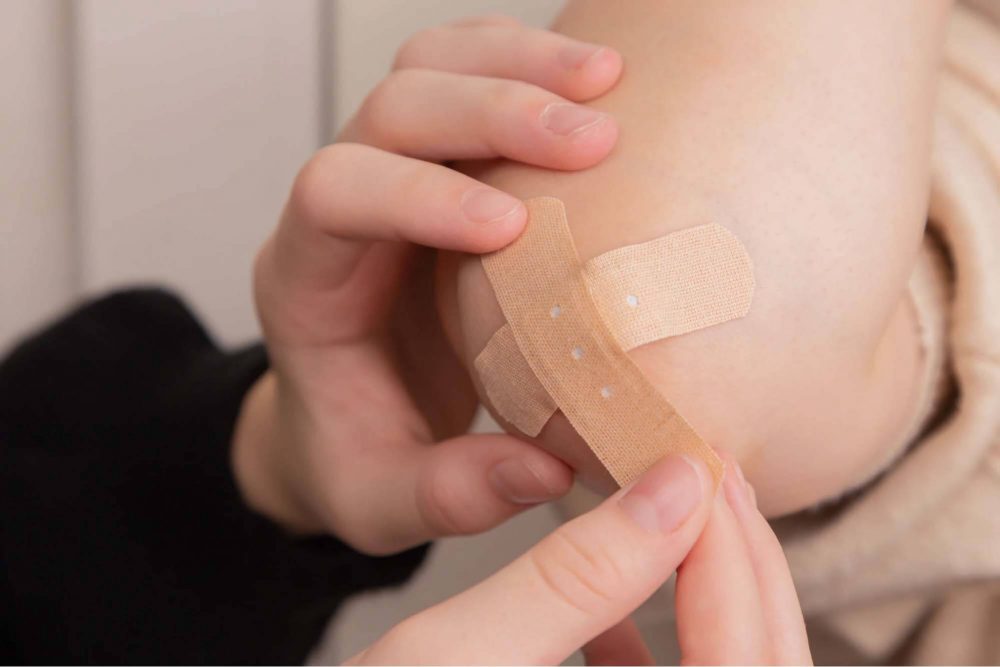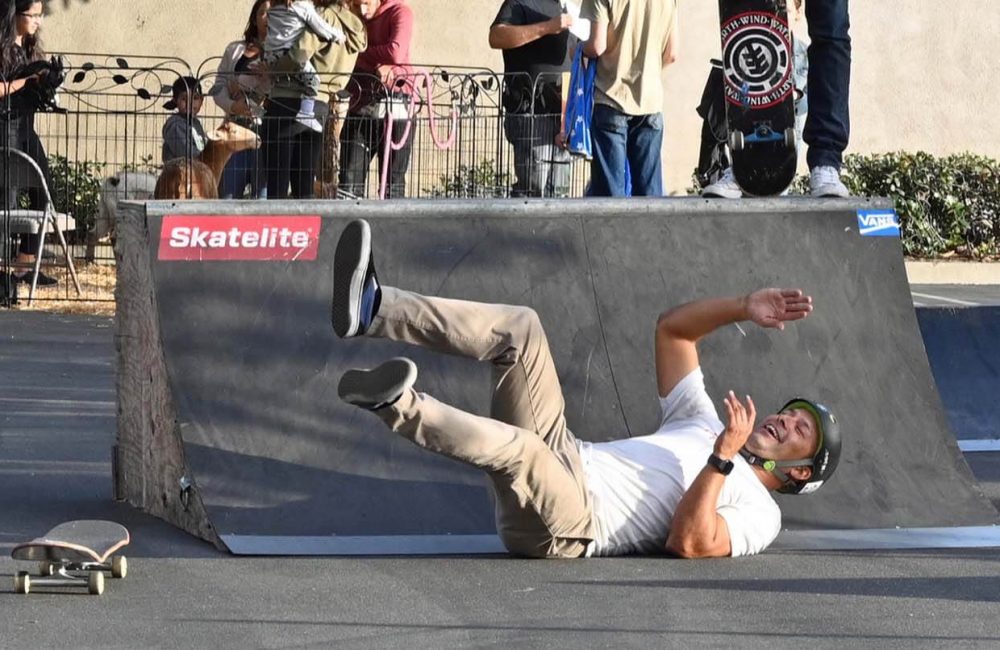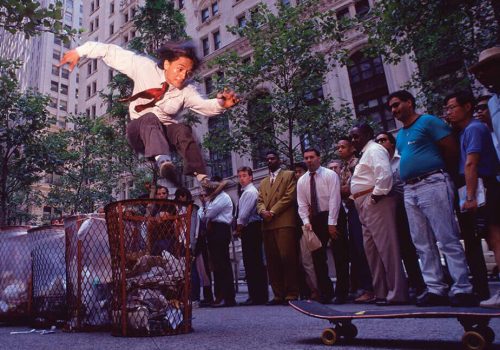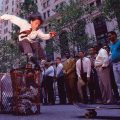When it comes to skateboarding, injuries are a part of the game. That doesn’t mean you should be scared to skate at the skatepark, but it does mean you’ll have to put effort into protecting your body from skateboarding injuries.
As a skater, even if you wear the proper protective gear, you’ll eventually endure ankle sprains and other common skateboarding injuries. Luckily for you, so has every other skater, pro or beginner, so we know all about the most common skateboarding injuries and how to prevent them.
After all, we have the largest collection of skateboarding instructors to source from and as we all know – when we fall back down, as skaters, we always get back up.
In this article, we’ll be going over:
- Most Common Skateboarding Injuries
- Most Common Skateboarding Accidents
- Healing Process of a Skate Injury
- How to Skateboard after Your Skate Injury
Want to learn how to skateboard but not sure where to get started? Congratulations! You’re off to the right start. We’ve crafted the most comprehensive blog and YouTube channel for learning how to skateboard.
Check out our latest articles and YouTube Videos to foster your skateboarding skills such as our article, “How to Skateboard at a Skatepark” and “How to Skateboard for the First Time.”
If you find yourself with a more serious injury after reading this article, contact your medical professional and or your parent or guardian. Lingering injuries can turn serious if not treated.
Most Common Skateboarding Injuries

The Most Common Skateboarding Injuries are NOT going to be the injuries your mom or grandmother warn you about. In fact, the most common skateboarding injuries are not actually serious injuries and happen no matter your skill level.
While these injuries sometimes require more significant medical attention, the majority of them are self healing injuries. Let’s go over them so after the first time they happen to you, you know exactly what you’re dealing with.
“Shinner” – It’s only a matter of time for a beginner skater to get their first shinner. As one might have guessed, it has to do with you shin. When your board, wheels, trucks, or what have you smash into your shin and cause an intense but ultimately brief amount of pain. It can happen skating flatground, ramps, and even curbs.
“Shark Bite” – A shark bite is honestly one of the most painful common skateboarding injuries because it happens when a skater is least expecting it. A “shark bite” is when another skater’s board veers off and hits your ankle or heel. This is why skaters will yell “Board!” like a golfer yelling “Fore!” It’s called a shark bite because you’re like a surfer sitting in the sea unsuspectedly and ‘boom’ you get bit.
Palm Bruise – Also commonly known as a shell bruise because of its shape, a palm bruise is a common but painful skateboarding injury. Observing the name, it’s when the palm of your hand gets bruised, usually looking like a seashell and hurting when you pick up your board.
“Hot Pocket” – A “Hot Pocket” is a silly name but it’s descriptively accurate. Every once in a while a skater will jump on their board with their initial push and a sharp pain will shoot through the top of their foot. Nobody really knows why this happens but it happens to all of us. Even if you’re popping Ollies or just cruising around.
Hip Flexor – A Hip Flexor is a bit more obtuse when it comes to how common it is. Essentially, your hip will feel tight, almost like you’re being stretched out or somehow less flexible. Pay close attention to a hip flexor as while they are common and usually pretty minor, they can develop into a chronic skateboarding injury.
Dead Leg – You might have heard of this one before in other aspects of your life. It’s that special part of your leg where if someone punches you, your entire leg seems to ache with pain. In skateboarding, this can happen from having your phone or car-keys in your pocket when you go to fall. If you’re lucky, you’ll be fine in a few minutes but many bad dead legs result in bruising and harsh range of motion for several days prior.
Rolled Ankle – A rolled ankle might be the most significant skateboarding injury on this list as it is both a common and serious injury. This happens when your ankle gives out and rolls over while you have your weight on it, twisting and causing severe pain and often balloon swelling. While it can be severe, resulting in weeks, even several months hiatus from your skateboard, sometimes a skateboarder will be able to skate the next day. But if you have limited range of motion after rolling your ankle, or can’t walk well, it’s best to seek sports medicine practices like the ones we are about to list below.
Pinched Nerve (Back Issues) – If you hang around older skateboarders at the skatepark, you’ll hear a handful of them complain about back pain. Many of these skaters have endured a pinched nerve once or twice in their skate career and can only be relieved by intense stretching and often physiotherapy.
Pulled Groin – In skateboarding, it’s not always about having a sprained ankle or a bum knee, rather often it’s the muscles, tendons, and hamstrings that fall victim to the physical battles of skating. Pulling your groin can be one of the worst common skate injuries to endure, as it makes the movement of your legs virtually impossible without pain. It can also happen out of nowhere which makes them particularly frustrating.
Most Common Skateboarding Accidents
These skateboarding “accidents” are sometimes avoidable, but most of these result from a skater testing their own merits. Truthfully, bombing hills and skitching cars are the two number one reasons a skater ends up in the hospital. Avoid those two when possible.
Hitting a Small Pebble or Rock – Every skater knows about the dreaded pebble or small walk on the sidewalk because at some point you will hit one of these bad boys and your skateboard will come to a screeching stop while you, well, you keep going – flying over and onto the pavement. Be careful to not have an outstretched arm, rather fall on your shoulder or hip and hopefully slide.
Speed Wobbles from Hill Bombing – The number one reasons a skateboarder will end up in the hospital is from bombing a hill. And what leads to the slam that sends them there? Speed wobbles. We highly discourage skaters from bombing hills unless expert level and wearing all protective gear possible. If there’s any doubt in your mind you can’t skate down something, just don’t.
Skitching a Car – Skitching a car, otherwise known as holding onto a car while someone is driving it, is the number 2 reason a skateboarder will end up in the hospital. Simply put, it is not worth it and is extremely dangerous. There’s plenty of horror stories out there to remind you not to try this one.
Skate Park Collision – This is probably the most common skateboarding accident which can often leave young skaters afraid of going to the skatepark. However, the more you skate the better you will get at navigating a skatepark and not getting into collisions. If you and another skater are speeding head on to one another, it’s best to turn around and slam back-to-back or shoulder-to-shoulder or stay still and hope they are the ones to jump in another direction.
Biker Collision – Skaters and bikers have a natural animosity because we operate in the same space and thus compete for that space. However, a skateboard can easily jump off their skateboard and avoid things in their path. A biker can not escape so easily but on the flip side, they are more protected by the metal horse they’re riding versus the skater who’s about to be plowed down. Bikers can also go much faster than a skater. Pay special attention to the space bikers are operating and make sure to not cross paths with their trajectory.
“Sacking it” – Sacking it means the unlucky person split their legs while skating down a rail and landed like open scissors on the rail compromising the family jewels. This is one of the most painful and iconic slams in skateboarding history and has scared many skaters from skating big handrails.
“Credit Card”–Credit Carding is possibly the most painful injury on this list as you might already be able to imagine what it means through its name. If you can’t, just imagine your board being placed up straight and you jumping onto it with your legs spread or your glutes inhaling the impact. This can happen while skating down a stair-set or even just on flatground.
Healing Process of a Skate Injury

The healing process of a skate injury is going to vary per injury but in general every skate injury has a foundational path to recovery. Being a skater means you need to be in-tune with your body and be able to listen to it first and foremost. From there you can follow these steps.
Step 1: Assess Your Injury for Medical Attention – The first thing you should do after sustaining an injury is assess if you need medical attention. We can not tell you the amount of times a skater should have gotten something looked at instead of just waiting for it to stop hurting. For too long skate culture has endorsed that type of behavior but now we see a conscious effort to not only encourage skaters to seek more traditional physical therapy, but mental health as well. It’s always a good idea to seek a medical opinion.
Step 2: Ice and Elevate – Generally, every skate injury will benefit from icing and elevating your injury. This is especially true for ankle, knee, elbow and other blunt force related injuries. The icing helps reduce swelling and promote blood flow which in turn brings healing powers throughout your body to heal your injury. The elevation promotes this as well.
Step 3: Limit Contact and Range of Motion – While this can come in the form of using crutches or other proper medical equipment to help you keep pressure off your injury or limit your range of motion, it’s also up to you throughout your daily life to limit as well. Sometimes we can mistake pain for progress and think testing our thresholds will lead us to breakthroughs. While this can be true with the proper medical attention, if it hurts to do something, then you probably shouldn’t do it.
Step 4: Allow Yourself to Heal – When it comes to healing a skate injury, skaters can either be their best friend or their worst enemy. Skaters always want to skate and when we have been off our board for an extended period of time, we can even have dreams about skating that turn into nightmares. You have to allow yourself time to heal and not risk reinjuring yourself by getting back on your board too soon. Take the time off to learn a new hobby or dive deeper into your love for skate magazines or skate video games.
Step 5: Test Your Limits – Contrary to our previous step, you do have to test your limits when it comes to the healing process of a skate injury. We don’t mean necessarily on your skateboard however. If you hurt your ankle, take a walk in the morning and see if you still have pain when you walk. If you have an achilles injury or a groin acting up, stretch and see how the range of motion meets your thresholds of pain. This can be a lifelong battle with chronic injuries but listening to your body and always testing the waters can help you not only heal but avoid injuries all together.
How to Skateboard after your Skate Injury

It can be difficult to fathom what it means to skateboard after an injury but anyone who has sustained a serious skate injury or deals with chronic skate injuries knows exactly what we’re talking about. It can come in the form of PTSD or even shake your confidence for the simpler things like skating in crowded spaces. So here is some advice on how to skateboard after a skate injury.
Maintain a positive mindset – We cannot stress enough that the worst part of sustaining a skate injury is what it does to you mentally. Often if you hurt yourself doing a trick, you might never want to try that trick again – and that’s totally okay. But a ton of skaters might not find that to be an option – and that’s also okay. However, sometimes that comes at the cost of stressing out or being really afraid to try certain tricks knowing the threat of another serious injury is always there. It’s important to remember that you are in control of your skate destiny and you don’t have to try anything you don’t want to. Most importantly, be kind to yourself and avoid a mindset that stresses you out to skate. Remember, it’s all about having fun.
Expand your Skate Repuitar (Skate something else) –Skating with an injury can often mean you have to take it easy in certain respects. Imagine you roll your ankle, so it practically hurts to skate flatground and practice flip tricks. Instead, drop in on a mini ramp or enjoy carving a bowl and getting more comfortable on a skate obstacle you’re not used to skating. There’s opportunity in skate injury but you have to be careful to not further your injury.
Develop a Pre-Skate and Post-Skate Routine – The aging skater knows this is a necessary condition to being able to keep skating the older you get. Developing a pre-skate and post-skate routine consisting of healthy habits is a sure way to making sure you’re able to skate for life. Stretching, drinking lots of water, massage, ice and practice physical therapy are all palpable routines to implement post and pre-skate.
Change Your Skate Set Up – Often as we navigate our skate careers, our board shapes and sizes will change. Some setups are more favorable to certain skate styles that reduce impact or certain stresses on the body. Research what set ups might be best for you or the types of board size more suitable for your type of injury rehabilitation.
Wear Protective Gear –The majority of adult skaters won’t actually wear protective skate gear, let alone a helmet. That doesn’t mean that you can’t wear a form of protective gear when rehabbing an injury. For example, a knee brace or an ankle brace or even a wrist guard are effective forms of protective gear. While obviously we want to recommend the full spectrum of protective skate gear, you can opt for temporary skate gear for protection when and where you need it.
Seek Professional Medical Advice – Listen, we know it can be expensive to pursue professional medical advice, let alone treatment. But you can’t put a price on health, especially when it comes to longevity on a skateboard. Seek a professional to help you develop a positive roadmap to full recovery. After all, that’s what the pro skaters you look up to are doing.
You can explore top tips on “How to avoid Skateboarding Injuries”














